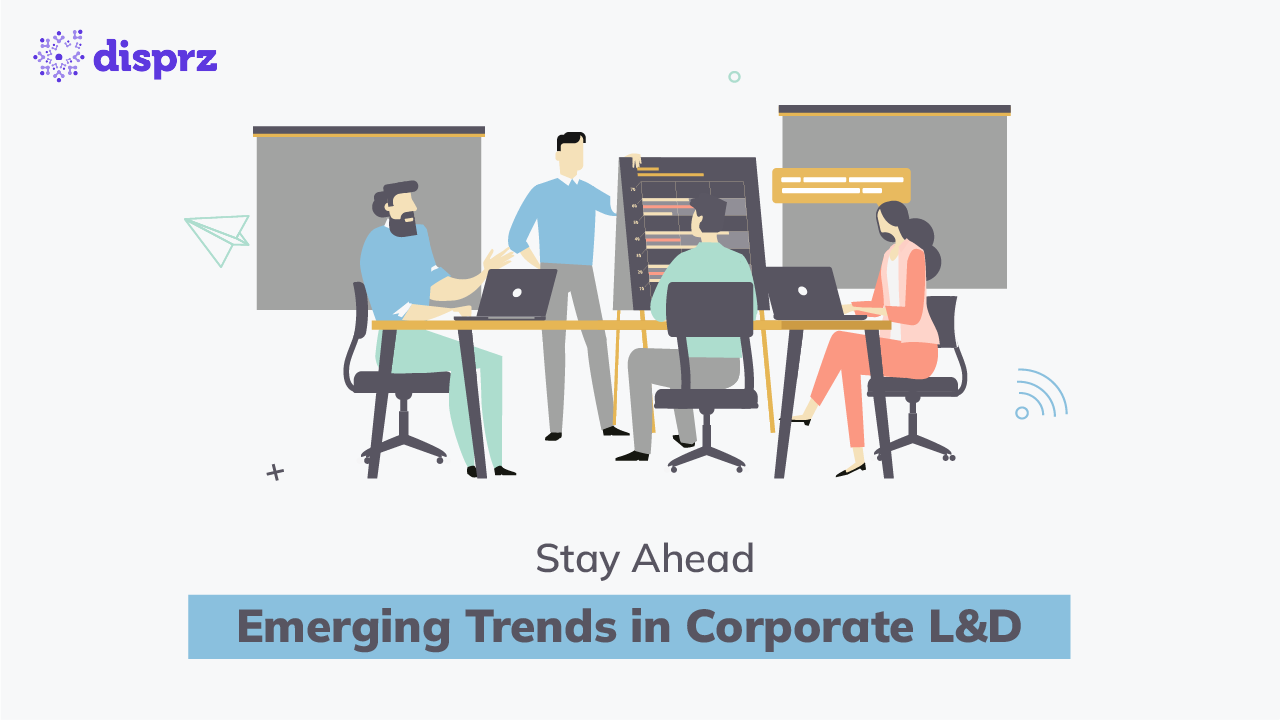Did you know that 88% of c-suite executives believe providing employees access to learning and development is critical to their organization’s business strategy to achieve their goals? Like the pandemic decimated many paradigms, businesses are having to cope with new ways to tackle the issues clutching the world in 2025.
L&D professionals are taking a closer look at the most recent learning and development trends to design employee upskilling programs that proactively deal with the upcoming challenges they will face this year. Continue reading to discover the latest L&D trends to enhance your strategies for 2025.
Top 10 Corporate Learning and Development Trends for 2025
- Role-based Skill Mapping & Assessment
- AI-Powered Personalized Learning
- In-Depth Learning Analytics
- Social & Collaborative Learning Through Technology
- All-In-One Learning Platform
- Immersive Learning Technologies: VR and AR Integration
- Emphasis on Soft Skills Development
- Microlearning for Just-in-Time Training
- Upskilling and Reskilling Initiatives
- Data-Driven Decision Making in L&D
In the post-covid era business leaders have witnessed the success of innovative learning and development trends introduced by the L&D leaders. These trends include blended learning, microlearning, immersive learning, gamification, and more. L&D teams continue to implement these strategies successfully in their corporate training to carry on the journey of digital transformation and talent development.
With the focus on driving organizational growth, here are the leading learning and development trends companies are now targeting to incorporate into their learning culture:
1) Role-based Skill Mapping & Assessment
Role-based skills have become pertinent for success, making skill mapping critical for leaders to recognize the right training content to build those skills. With corporate the current dynamic setting, it’s no longer just for the technical or functional skills, but role-based specializations that have taken precedence.
Organizations can achieve collective outcomes by utilizing a combination of corporate learning and development strategies and tactics on two main fronts:
-
Bolster the internal talent pool by incorporating in-demand skills
-
Synchronize the talent strategy with the overall goals of the organization
Skill mapping and assessment are two sides of the same coin. Skill mapping helps an organization identify the required skills and creates a skill inventory. The next step is to assess the employee’s proficiency level for the identified skills with the right skill assessment.
For example, in the retail sector, a sales associate should have the knowledge and skills to convert a potential prospect into a customer, but when assessed on product skills, the sales associate needs a little more proficiency in product knowledge.
The L&D team can plan a journey to enhance that skill, ensuring customer satisfaction and sales growth. Businesses can stay ahead with assessments and training by curating the right training content to bridge any identified skill gaps.
2) AI-Powered Personalized Learning
As roles within organizations become specialized, personalized learning is necessary for employees to acquire the skills needed to perform their job efficiently. Personalization allows learners to focus on the relevant skills and knowledge rather than a one-size-fits-all approach. By introducing personalization to your corporate learning and development programs, you can improve employee development, engagement, retention, and overall job performance.
In 2025, learning teams can personalize the entire skilling journey effortlessly with AI-powered employee learning platforms. AI-driven personalized learning helps L&D leaders identify and address skill gaps by analyzing performance data and identifying areas where they need improvement.
3) In-Depth Learning Analytics
As a leader, you must enhance the efficacy of your strategy by incorporating learning analytics techniques. This L&D trend enables you to gain valuable insights and make data-driven decisions, elevating the impact of your organization’s training initiatives. Prove the value of your learning investments and drive business results with hard data, not just words.
With the aid of technology, corporate L&D heads can utilize the comprehensive view of learning analytics for the right information to target your investment, as it demonstrates the ROI of each learning module. It’s a learner-centric approach that helps learning professionals identify areas where employees struggle and to make informed decisions in the future.
4) Social & Collaborative Learning Through Technology
Social & collaborative learning promotes an engaging and effective way to train employees. This L&D trend gives employees a platform to learn from their peers by encouraging knowledge sharing and collaborating on projects, resulting in increased productivity, job satisfaction, and ultimately, the success of the company.
Social and collaborative learning can occur both synchronously and asynchronously within the organization. You can leverage advanced platforms like a Learning Experience Platform (LXP) to facilitate employees’ acquisition skills via seamless access to diverse learning content. This creates a sense of community building where learners, as they not only work towards their own personal and professional development but also contribute to the growth and development of their colleagues.
5) All-In-One Learning Platform
Gone are the days of using multiple platforms for training, analytics, and more. Today, L&D teams can drive all corporate learning and development efforts on a single, all-in-one learning management system, making it easy to monitor employee progress and ensure everyone is on track to reach their goals. They can gain valuable insights and make data-driven decisions to improve training programs and drive better outcomes. The platform also eliminates employees’ need to switch between multiple applications, making the learning experience more seamless. This supports employees to learn in the flow of work without leaving their digital tools.
Among these top trends in training and development, this one definitely tops the list. That’s because a single access platform enables access to training material at the moment of need, resulting in more engaging and interactive learning, reduced onboarding time, and improved productivity.
6) Immersive Learning Technologies: VR and AR Integration
Immersive technologies such as Virtual Reality (VR) and Augmented Reality (AR) are revolutionizing employee training by offering experiential learning opportunities. These technologies enable learners to engage in realistic simulations, enhancing skill acquisition and retention. For instance, VR can simulate complex scenarios such as emergency response drills, allowing employees to practice and refine their reactions in a controlled environment. AR can overlay digital information onto physical settings, aiding tasks such as equipment maintenance by providing real-time guidance.
Organizations in sectors such as manufacturing, healthcare, and retail are leveraging VR and AR to enhance hands-on training experiences. These tools help reduce training costs by minimizing the need for physical resources and enabling remote learning. Additionally, immersive learning fosters deeper engagement by creating interactive, real-world experiences. With the growing accessibility of these technologies, organizations can scale their learning programs more efficiently, providing employees with engaging, on-demand, and highly effective training solutions.
7) Emphasis on Soft Skills Development
As automation and artificial intelligence handle more routine tasks, the demand for uniquely human skills (such as emotional intelligence, communication, and critical thinking) has surged. Organizations are prioritizing soft skills training to foster effective collaboration and leadership. Workshops and coaching sessions that focus on empathy, adaptability, and problem-solving are becoming integral to L&D programs. A workforce equipped with strong soft skills is more agile, adaptable, and better prepared to handle challenges in today’s fast-changing business landscape.
Organizations are incorporating AI-driven coaching, interactive storytelling, and gamified learning experiences to make soft skills training more engaging. In hybrid and remote work environments, effective communication and teamwork have become essential, making these skills even more crucial. Additionally, soft skills development contributes to a positive workplace culture by promoting inclusivity, active listening, and constructive feedback. Organizations that invest in these areas build a workforce that thrives in dynamic, customer-centric, and collaborative environments, ensuring long-term business success.
8) Microlearning for Just-in-Time Training
Microlearning delivers content in short, focused segments, catering to the modern learner’s preference for concise information. This approach allows employees to access training materials on-demand, fitting learning into their schedules seamlessly. For example, a sales representative might watch a five-minute video on a new product feature before a client meeting. Unlike lengthy training programs, microlearning helps employees acquire relevant knowledge without disrupting their workflow. It is particularly useful for frontline workers, customer service teams, and mobile workforces who need quick, actionable insights.
Organizations are increasingly using AI-driven adaptive learning to deliver personalized microlearning experiences tailored to individual needs. With mobile-friendly formats, bite-sized learning modules can be consumed anytime, anywhere, enhancing accessibility. This method also improves retention, as research suggests that breaking down information into digestible chunks leads to better recall. By integrating microlearning into L&D strategies, organizations can foster continuous learning without overwhelming employees with lengthy and time-consuming courses.
9) Upskilling and Reskilling Initiatives
The rapid pace of technological advancement necessitates continuous learning. Organizations are investing in upskilling (enhancing current skills) and reskilling (training for new roles) to maintain a competitive edge. These initiatives address skill gaps and prepare employees for evolving job requirements. For instance, a marketing professional might receive training in data analytics to adapt to the increasing importance of data-driven decision-making. The rise of automation and AI is accelerating the need for workforce transformation, making these programs a business imperative. L&D teams are leveraging AI-powered learning platforms to analyze skills gaps and create targeted upskilling paths.
Continuous learning opportunities also improve employee retention, as workers are more likely to stay with employers who invest in their growth. Organizations are partnering with industry experts, universities, and online learning platforms to offer structured reskilling programs. By implementing strategic upskilling initiatives, organizations can future-proof their workforce and remain competitive in an ever-evolving business landscape.
10) Data-Driven Decision Making in L&D
Leveraging data analytics in L&D enables organizations to measure the effectiveness of training programs and make informed decisions. By analyzing metrics such as learner engagement, knowledge retention, and performance improvement, organizations can tailor their training strategies to better meet employee needs. For example, if data reveals low engagement in a particular module, L&D professionals can investigate and modify the content or delivery method. Predictive analytics can identify trends in learning behavior, helping organizations proactively address skill gaps before they impact productivity. AI-powered learning analytics provide deep insights into the impact of training on business outcomes, ensuring that L&D initiatives align with corporate objectives.
Organizations are also using sentiment analysis and feedback tools to assess employee satisfaction with training programs. With real-time dashboards and interactive reporting, decision-makers can continuously refine learning strategies. By adopting a data-driven approach, organizations can maximize ROI on training investments while delivering more personalized and impactful learning experiences.
The Bottom Line
2025 is a year of change and uncertainty for businesses, and organizations will need to adapt and find new ways to train and develop their corporate workforce. The above learning and development trends allow organizations to create engaging learning experiences, and foster a continuous learning culture.
Advanced AI-driven learning platforms like Disprz LXP provide a comprehensive learning solution for corporate employee training to manage and deliver these and similar trends on a single platform, which makes it an essential tool for any organization that wants to train its workforce effectively.
By incorporating these learning and development trends into your strategy, you can ensure that your employees have the knowledge, skills, and abilities to meet the demands of their roles and the organization’s overall objectives.
Take your corporate workforce training up a notch with Disprz LXP.









